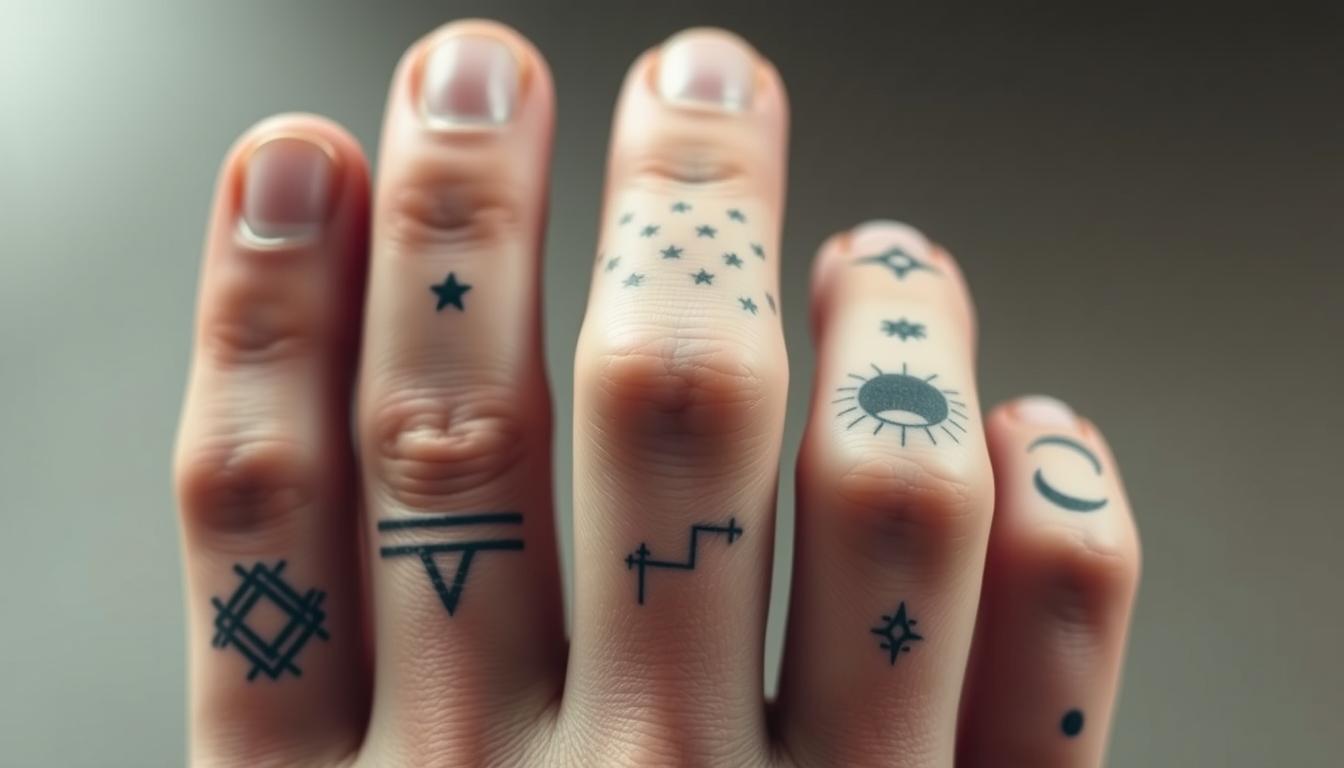
Have you ever wondered how a tiny mark on your hand can reshape your image and spark conversation?
We explore popular small-scale ink trends and show how simple lines, script, and nautical symbols can make a bold statement. Black ink often wins for contrast and durability, while subtle color accents add personality without sacrificing longevity.
Many choose cohesive art across several digits to create a unified look that still reads clean in photos and daily life. Celebrities like Zayn Malik and David Beckham have pushed visibility, helping these pieces fit into casual and professional settings.
We outline placement options from discreet side positions to knuckle spreads, and we preview meaning-driven choices—initials, dates, or symbols that feel personal. Expect practical tips on planning, touch-ups, and aftercare so your body art stays crisp over time.
Key Takeaways
- Minimalist shapes and script are trending for their versatility.
- Black ink lasts longer; small color accents can work when planned.
- Cohesive multi-digit art creates a unified hand design.
- Placement choices balance visibility with workplace needs.
- Plan for touch-ups and realistic wear over time.
Why finger tattoos men are trending right now in the U.S. (and how we wear them)
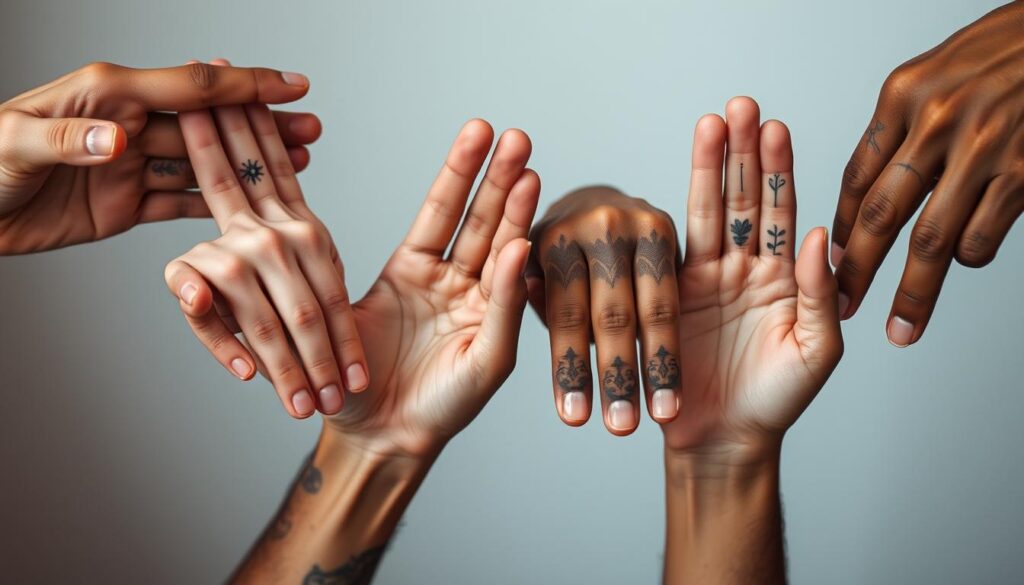
Across the U.S., compact hand ink is rising because it offers both subtlety and statement.
We see three big forces pushing this trend. First, versatility: small hand pieces hide under sleeves or stand out when we want them to. Second, wider workplace acceptance lets many keep art low-key at work and bold after hours. Third, celebrities like Zayn Malik, David Beckham, and Lewis Hamilton made visible hand work familiar and aspirational.
The social web speeds everything up. A clear image on Instagram or TikTok turns a tiny design into a global idea overnight. That gives us more reference shots to bring to an artist when we plan a new mark.
Placement matters. Side placements keep designs discreet. Knuckles and tops of digits read loud and feel daring. We suggest starting small: fine lines, tiny symbols, or clean lettering. These quick-start tattoo ideas men can explore with an artist in one session.
| Reason | What it means for us | Quick action |
|---|---|---|
| Versatility | Hide or show ink depending on the occasion | Choose side placement or thin script |
| Celebrity influence | Normalizes visible hand work across ages | Use photos of admired styles as references |
| Social amplification | Trends move faster and ideas spread globally | Save clear shots to discuss size and contrast |
“Small-scale work can carry a big meaning when composed well.”
We also remind readers that scale affects longevity. Smaller marks need careful placement and occasional touch-ups. Planning for maintenance keeps our image sharp for years and helps us wear these designs with confidence into 2025 and beyond.
Finger tattoo ideas for men: designs, symbols, and artwork with meaning
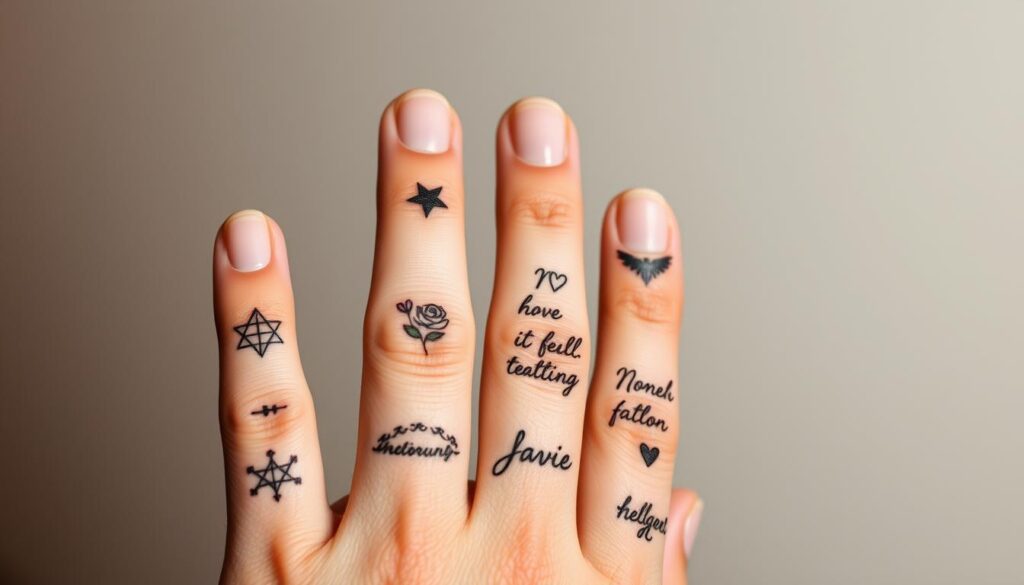
Small symbols can tell big stories when we pick the right micro designs for our hands.
Minimalist shapes and clean lines work best when space is tight. Thin black strokes and simple geometry keep edges sharp and age well.
- Script & initials: readable fonts, proper spacing, and light stroke weight make dates or initials last.
- Faith symbols: tiny crosses or talismans for daily grounding and protection without crowding the skin.
- Crowns & lightning: pared-down crowns for leadership and simple bolts for energy and change.
- Numbers: Roman numerals and single digits mark milestones with subtlety.
- Tribal & wrap patterns: repeatable lines that circle a digit while keeping consistent line weight.
- Nautical & nature: anchors, waves, stars, and tree silhouettes for balance, guidance, and growth.
- Hearts & infinity: minimalist love icons that read clearly at a glance.
We recommend building a reference board of tattoo ideas and refining one cohesive small design per digit. Use black for contrast and reserve color as a tiny accent.
“Choose crisp shapes over detail-heavy art—clarity wins on small surfaces.”
Placement guide: from subtle to statement on fingers and hand
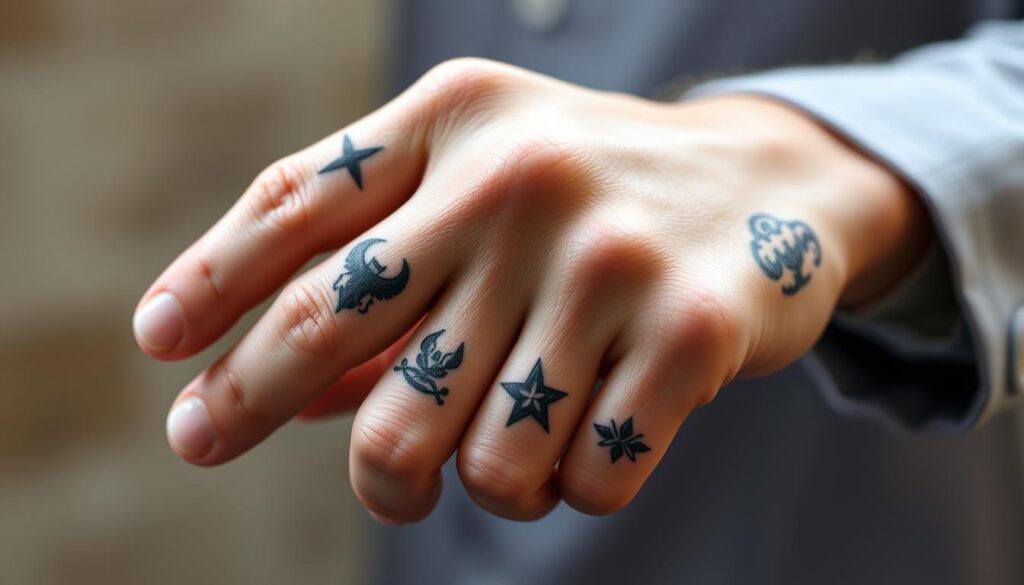
Placement changes how a small mark reads on the hand, from secret messages to bold declarations.
Knuckles are the classic spot for an instant statement. Spacing letters across adjacent digits improves readability and gives a punchy image. Knuckle work reads loud and suits bold forms rather than tiny detail.
Knuckles for classic impact and bold statements
We pick thick, steady line weight for this area. That helps the design hold up as skin moves and ages.
Side finger tattoos for a discreet, easily concealable look
Side placements hide well under sleeves or rings. They suit short words, dates, or a single icon and work for formal settings where subtlety matters.
Inside finger ink for private symbols and mantras
Inside placements feel intimate but face heavy wear. Expect touch-ups and choose compact forms that use the limited space efficiently.
Thumb tattoos for wider, square or oval designs
The thumb gives more space for square or oval icons. Use bold shapes that match the broader surface and avoid tiny filigree.
Webbing tattoos between thumb and index for unique flair
Web placements stand out but are less painful than palms. They add flair and work well with small symbols that flow toward the wrist.
Whole hand and multi-finger compositions for a cohesive design
When we design across several digits, we match line weight and form to create balance. Test placements with a skin-safe marker to check spacing and image harmony.
“Fingers are a high-motion part of the body; choose resilient linework and avoid micro details.”
- Quick note: under-finger and palm work blur faster and need an experienced artist.
- Plan for maintenance and realistic wear when you map out any hand design.
Ring finger tattoos for men: wedding bands, cover-ups, and commitment
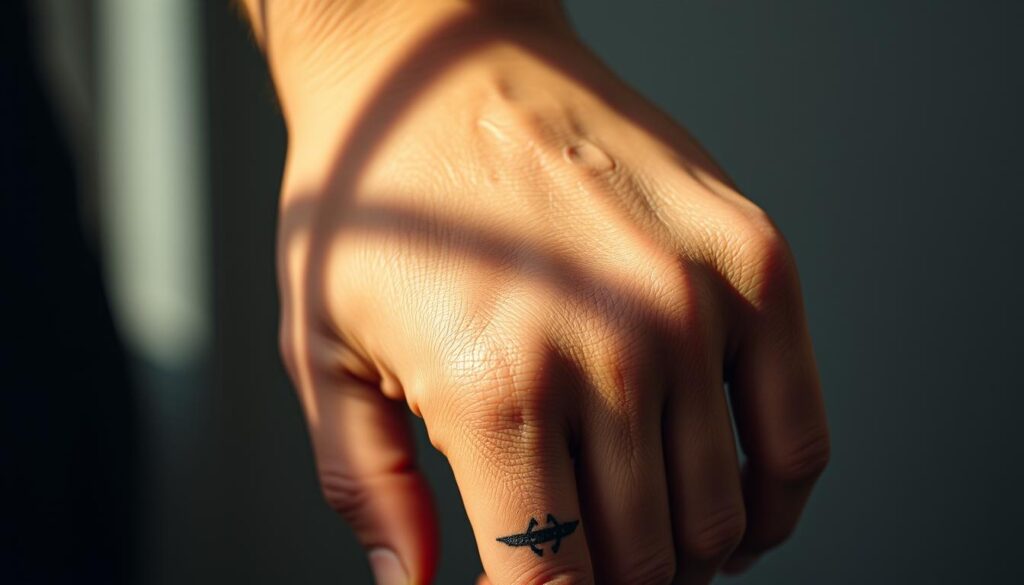
We often treat the ring finger as a canvas for promises that outlast metal.
Minimal bands, initials, and dates work well when we want a low-profile symbol of love and commitment. Thin black bands, tiny initials inside a narrow line, or a compact date read clearly and photograph well from arm’s length.
Minimal bands, initials, and dates as everyday symbols of love
Minimal bands echo real wedding rings without bulk. Initials can sit inside a thin band or stand beside it, and simple serif or sans-serif fonts keep letters legible at this scale.
Cover-up strategies to refresh old ink with meaningful designs
For cover-ups, we favor clean shapes and heavier black to mask old lines. A bold band, a dark geometric wrap, or a small symbol layered over faded ink gives fresh meaning and hides flaws.
Matching couple artwork that balances style and sentiment
Couples often choose matching slim bands or complementary symbols like half-infinity pieces that align when hands join. Plan placement—top, side, or full wrap—based on daily ring use.
- Aftercare: avoid wearing a metal ring while healing, keep the area moisturized, and limit friction.
- Timing: schedule the session a few weeks before any major event to allow swelling to subside.
- Future-proofing: use high-contrast black for longevity and test how the design reads in photos.
- Consider pairing a ring symbol with a tiny heart or infinity on an adjacent digit for a connected story.
“A simple band can carry the weight of vows while staying elegant and low-maintenance.”
For more small-cute options and reference images, see our guide to small cute tattoo ideas.
Style and ink choices: blackwork, fine lines, and color accents
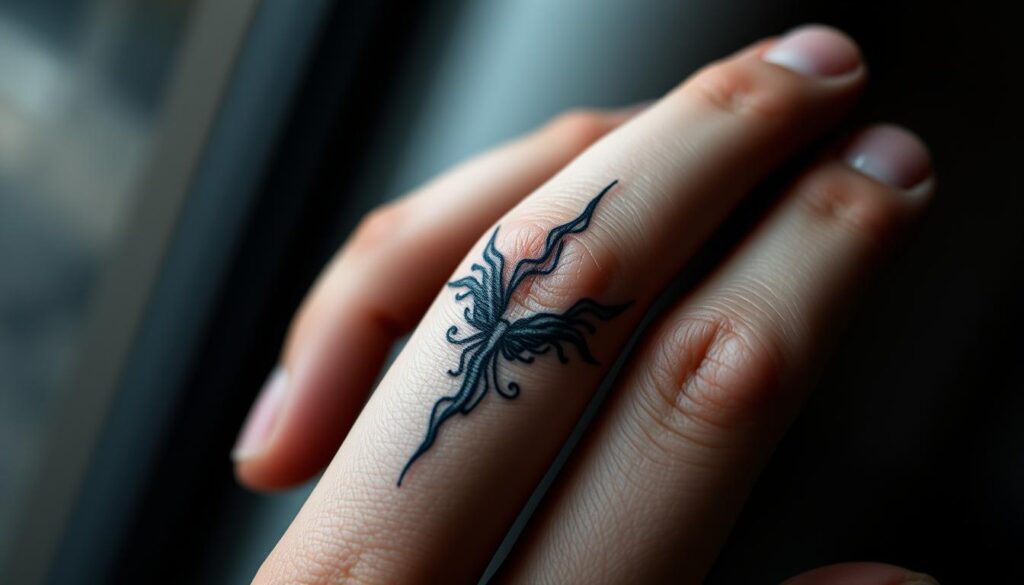
We pick ink and style to make small hand marks read clearly and last longer.
Black ink is the workhorse for these designs. High contrast holds up as lines soften with time. For most small placements, black keeps shape and clarity better than saturated color.
That said, tiny color accents—dots, micro fills, or a thin outline—can personalize a piece without muddying detail. Test swatches on similar skin tones with your artist to see healed results.
Line weight and durability
Fine lines feel elegant but may blur faster on moving skin. Slightly thicker strokes improve longevity while keeping a minimalist look.
Lettering and font selection
We favor simple serif or sans-serif fonts. Proper spacing and avoiding ultra-thin hairlines keeps text legible. Use stencil tweaks around joints so letters don’t warp when you bend your hand.
- Match line weight across multiple digits for a cohesive image.
- Use repeated motifs and mirrored spacing to balance artwork.
- Build a small library of tattoo designs to compare proportions before approval.
“Tattoos perfect on hands prioritize clarity, contrast, and negative space.”
| Choice | When to use | Benefit |
|---|---|---|
| Blackwork | All small designs and scripts | Best contrast and longevity |
| Fine lines | Delicate script or single-line icons | Elegant look, needs touch-ups sooner |
| Color accents | Small fills, dots, outlines | Personalizes without overwhelming |
| Thicker strokes | High-motion areas and knuckles | Greater durability and legibility |
For blackwork examples and reference, see our blackwork reference.
Meanings that matter: personal significance behind the symbols
Small marks often carry the deepest stories—compact icons can act as daily reminders of who we are.
Faith and protection often show as crosses, talismans, or simple anchors. These tiny choices give a sense of grounding and safety without needing large canvases.
Faith, protection, and life journeys in compact artwork
We pick arrows for direction, crowns for self-mastery, and anchors for stability. Pairing a symbol with a date or initials deepens the personal significance while keeping the design clean.
Family bonds: “Mom,” “Dad,” kids’ names, and initials
Initials, Roman numerals, or small names honor loved ones. Place very personal marks on the inside of a digit to keep them private but close.
- Research cultural origins before using ancient or tribal symbols to show respect.
- Try a quick journal exercise: list core values, then map each to one clear icon.
- Remember restraint—fewer, stronger symbols age better and read clearly.
“Meaningful micro-icons often become our most-worn artwork; choose symbols that will still feel right in ten years.”
Care, longevity, and touch-ups: keeping finger tattoos fresh
A short care plan and smart habits extend the life of compact hand artwork. We focus on simple steps that protect small marks while they heal and across years of wear.
Healing basics:
Moisture, minimal friction, and sun protection
Day one: gently clean with mild soap, pat dry, and apply a thin layer of a scent-free moisturizer. Follow your artist’s dressing instructions exactly.
Avoid heavy rings, tight gloves, and repetitive rubbing while the area settles. After healing, use high-SPF sunscreen on exposed work to slow fading.
Fading, placement wear, and when to plan touch-ups
Hands see more washing and flexing, so expect gradual softening of lines. Inside and under-digit areas fade faster and often need refresh work.
- First check-in: about 6–8 weeks after the session.
- Plan yearly assessments; color accents usually need refreshes sooner than black ink.
- Use scent-free lotion and avoid harsh chemicals during healing.
- Pro tip: schedule the session when you can limit intense hand use for a few days.
“Realistic expectations and steady care keep small designs looking sharp.”
For procedure pain and healing context, see do hand tattoos hurt?
finger tattoos men: our best tips for choosing ideas and designs
Start by naming what you want the mark to mean, then narrow choices to three to five clear icons or words.
We begin with purpose. List the story or feeling you want the design to carry, then shortlist symbols like anchors, crowns, crosses, or numerals. Keep a single idea per digit so the overall image stays clean.
Test scale and placement. Cut paper shapes or use temporary transfers to check readability at arm’s length. Try a knuckle piece for statement and a side or inside mark for discreet wear.
Start with black lines for durability and add tiny color accents only if they truly lift the design. Favor clear shapes and fonts that won’t close up as the skin ages.
- Balance bold knuckle work with subtler side marks for daily flexibility.
- Double-check initials, dates, and spellings before you commit.
- Bring reference images and be open to pro tweaks for longevity.
“Meaning, scale, placement, contrast, and a maintenance plan keep your choice looking sharp for years.”
Conclusion
Simple marks often make the biggest impressions when they live on our hands.
We close with one clear idea: a small canvas can have big impact. Thoughtful black linework gives the best chance that detail stays crisp on high-wear areas like knuckles, sides, inside digits, thumbs, webbing, and under-finger spots.
Anchor your choice in real meaning—love, milestones, a mantra—and build a simple plan with your artist: design, placement, aftercare, and touch-up timing. Use restraint; clear shapes and negative space help artwork age well.
These marks live in the world and in our daily life. Save your top picks and book a consult to turn ideas men care about into durable, polished ink that fits your life.
